Genome-Wide Identification and Expression Analysis of NF-YA Gene Family in the Filling Stage of Wheat (Triticum aestivum L.)
Abstract
:1. Introduction
2. Results
2.1. Conserved Domains, Phylogenetic Relationships and Chromosomal Distribution of TaNF-YAs in Wheat
2.2. Analysis of Conserved Motifs and Gene Structure of TaNF-YAs
2.3. Intraspecific and Intermediate Collinearity Analysis of TaNF-YAs
2.4. Analysis of cis-Acting Elements in the Promoter of TaNF-YAs in Wheat
2.5. Haplotype Analysis of NF-YAs in Wheat
2.6. Analysis of TaNF-YAs Expression Pattern Based on RNA-Seq
2.7. Expression Level Detection and Autoactivating Activity Verification
3. Discussion
3.1. Functional Prediction of TaNF-YAs in Grain Development
3.2. RNA-Seq Analysis of TaNF-YAs Among Different Varieties
3.3. Haplotype Analysis of TaNF-YAs
4. Materials and Methods
4.1. Plant Materials
4.2. Genome-Wide Identification of NF-YA Genes in Wheat
4.3. Conserved Domains, Phylogenetic Relationships, and Chromosomal Distribution
4.4. Gene Structure and Conserved Motifs Analysis of TaNF-YAs
4.5. Collinearity Analysis of TaNF-YAs
4.6. Analysis of cis-Acting Elements of TaNF-YAs in Wheat
4.7. GO Enrichment and Haplotype Analysis of TaNF-YAs
4.8. Gene Expression Analysis of Wheat
4.9. qRT-PCR Analysis
4.10. Transcriptional Activation Assay
4.11. Statistical Analysis
5. Conclusions
Supplementary Materials
Author Contributions
Funding
Institutional Review Board Statement
Informed Consent Statement
Data Availability Statement
Conflicts of Interest
References
- Mantovani, O.R. NF-Y binding to twin CCAAT boxes: Role of Q-rich domains and histone fold helices. J. Mol. Biol. 1999, 285, 1441–1455. [Google Scholar]
- Mantovani, R. The molecular biology of the CCAAT-binding factor NF-Y. Gene 1999, 239, 15–27. [Google Scholar] [CrossRef] [PubMed]
- Zhao, H.; Wu, D.; Kong, F.; Lin, K.; Zhang, H.; Li, G. The Arabidopsis thaliana nuclear factor Y transcription factors. Front. Plant Sci. 2017, 7, 2045. [Google Scholar] [CrossRef] [PubMed]
- Bi, W.; Wu, L.; Coustry, F.; De Crombrugghe, B.; Maity, S.N. DNA binding specificity of the CCAAT-binding factor CBF/NF-Y. J. Biol. Chem. 1997, 272, 26562–26572. [Google Scholar] [CrossRef]
- Matuoka, K.; Chen, K.Y. Nuclear factor Y (NF-Y) and cellular senescence. Exp. Cell Res. 1999, 253, 365–371. [Google Scholar] [CrossRef]
- Lv, M.; Cao, H.; Wang, X.; Zhang, K.; Si, H.; Zang, J.; Xing, J.; Dong, J. Identification and expression analysis of maize NF-YA subunit genes. PeerJ 2022, 10, e14306. [Google Scholar] [CrossRef]
- Xing, Y.; Zhang, S.; Olesen, J.T.; Rich, A.; Guarente, L. Subunit interaction in the CCAAT-binding heteromeric complex is mediated by a very short alpha-helix in HAP2. Proc. Natl. Acad. Sci. USA 1994, 91, 3009–3013. [Google Scholar] [CrossRef]
- Dolfini, D.; Gatta, R.; Mantovani, R. NF-Y and the transcriptional activation of CCAAT promoters. Crit. Rev. Biochem. Mol. Biol. 2012, 47, 29–49. [Google Scholar] [CrossRef]
- Siefers, N.; Dang, K.K.; Kumimoto, R.W.; Bynum IV, W.E.; Tayrose, G.; Holt, B.F., III. Tissue-specific expression patterns of Arabidopsis NF-Y transcription factors suggest potential for extensive combinatorial complexity. Plant Physiol. 2009, 149, 625–641. [Google Scholar] [CrossRef]
- Stephenson, T.J.; McIntyre, C.L.; Collet, C.; Xue, G.-P. Genome-wide identification and expression analysis of the NF-Y family of transcription factors in Triticum aestivum. Plant Mol. Biol. 2007, 65, 77–92. [Google Scholar] [CrossRef]
- Thirumurugan, T.; Ito, Y.; Kubo, T.; Serizawa, A.; Kurata, N. Identification, characterization and interaction of HAP family genes in rice. Mol. Genet. Genom. 2008, 279, 279–289. [Google Scholar] [CrossRef] [PubMed]
- Zhang, Z.; Li, X.; Zhang, C.; Zou, H.; Wu, Z. Isolation, structural analysis, and expression characteristics of the maize nuclear factor Y gene families. Biochem. Biophys. Res. Commun. 2016, 478, 752–758. [Google Scholar] [CrossRef] [PubMed]
- Zhang, Q.; Zhang, J.; Wei, H.; Fu, X.; Ma, L.; Lu, J.; Wang, H.; Yu, S. Genome-wide identification of NF-YA gene family in cotton and the positive role of GhNF-YA10 and GhNF-YA23 in salt tolerance. Int. J. Biol. Macromol. 2020, 165, 2103–2115. [Google Scholar] [CrossRef]
- Quan, S.; Niu, J.; Zhou, L.; Xu, H.; Ma, L.; Qin, Y. Identification and characterization of NF-Y gene family in walnut (Juglans regia L.). BMC Plant Biol. 2018, 18, 255. [Google Scholar] [CrossRef]
- Ren, C.; Zhang, Z.; Wang, Y.; Li, S.; Liang, Z. Genome-wide identification and characterization of the NF-Y gene family in grape (Vitis vinifera L.). BMC Genom. 2016, 17, 605. [Google Scholar] [CrossRef]
- Quach, T.N.; Nguyen, H.T.; Valliyodan, B.; Joshi, T.; Xu, D.; Nguyen, H.T. Genome-wide expression analysis of soybean NF-Y genes reveals potential function in development and drought response. Mol. Genet. Genom. 2015, 290, 1095–1115. [Google Scholar] [CrossRef]
- Panahi, B.; Mohammadi, S.A.; Ruzicka, K.; Abbasi Holaso, H.; Zare Mehrjerdi, M. Genome-wide identification and co-expression network analysis of nuclear factor-Y in barley revealed potential functions in salt stress. Physiol. Mol. Biol. Plants 2019, 25, 485–495. [Google Scholar] [CrossRef]
- Mu, J.; Tan, H.; Hong, S.; Liang, Y.; Zuo, J. Arabidopsis transcription factor genes NF-YA1, 5, 6, and 9 play redundant roles in male gametogenesis, embryogenesis, and seed development. Mol. Plant 2013, 6, 188–201. [Google Scholar] [CrossRef]
- Zhang, M.; Hu, X.; Zhu, M.; Xu, M.; Wang, L. Transcription factors NF-YA2 and NF-YA10 regulate leaf growth via auxin signaling in Arabidopsis. Sci. Rep. 2017, 7, 1395. [Google Scholar] [CrossRef]
- Li, S.; Su, T.; Wang, L.; Kou, K.; Kong, L.; Kong, F.; Lu, S.; Liu, B.; Fang, C. Rapid excavating a FLOWERING LOCUS T-regulator NF-YA using genotyping-by-sequencing. Mol. Breed. 2021, 41, 45. [Google Scholar] [CrossRef]
- Leyva-González, M.A.; Ibarra-Laclette, E.; Cruz-Ramírez, A.; Herrera-Estrella, L. Functional and transcriptome analysis reveals an acclimatization strategy for abiotic stress tolerance mediated by Arabidopsis NF-YA family members. PLoS ONE 2012, 7, e48138. [Google Scholar] [CrossRef] [PubMed]
- Li, W.-X.; Oono, Y.; Zhu, J.; He, X.-J.; Wu, J.-M.; Iida, K.; Lu, X.-Y.; Cui, X.; Jin, H.; Zhu, J.-K. The Arabidopsis NFYA5 transcription factor is regulated transcriptionally and posttranscriptionally to promote drought resistance. Plant Cell 2008, 20, 2238–2251. [Google Scholar] [CrossRef] [PubMed]
- Fornari, M.; Calvenzani, V.; Masiero, S.; Tonelli, C.; Petroni, K. The Arabidopsis NF-YA3 and NF-YA8 genes are functionally redundant and are required in early embryogenesis. PLoS ONE 2013, 8, e82043. [Google Scholar] [CrossRef] [PubMed]
- Li, T.; Zhang, H.; Liu, Z.; Deng, H.; Sharma, S.; Wei, X.; Wang, L.; Niu, B.; Chen, C. A group of nuclear factor Y transcription factors are sub-functionalized during endosperm development in monocots. J. Exp. Bot. 2018, 69, 2495–2510. [Google Scholar]
- Wang, Y.; Xu, W.; Chen, Z.; Han, B.; Haque, M.E.; Liu, A. Gene structure, expression pattern and interaction of Nuclear Factor-Y family in castor bean (Ricinus communis). Planta 2018, 247, 559–572. [Google Scholar] [CrossRef]
- Wang, G.; Li, X.; Dong, J.; Jin, R.; Yang, L.; Huo, L.; Chen, L.; Zhao, W.; Gao, X. Proteomics unravels new candidate genes of Dasypyrum villosum for improving wheat quality. J. Proteom. 2021, 245, 104292. [Google Scholar] [CrossRef]
- Chang, S.; Chen, Q.; Yang, T.; Li, B.; Xin, M.; Su, Z.; Du, J.; Guo, W.; Hu, Z.; Liu, J.; et al. Pinb-D1p is an elite allele for improving end-use quality in wheat (Triticum aestivum L.). Theor. Appl. Genet. 2022, 135, 4469–4481. [Google Scholar] [CrossRef]
- Zhu, T.; Wang, L.; Rimbert, H.; Rodriguez, J.C.; Deal, K.R.; De Oliveira, R.; Choulet, F.; Keeble-Gagnère, G.; Tibbits, J.; Rogers, J. Optical maps refine the bread wheat Triticum aestivum cv. Chinese Spring genome assembly. Plant J. 2021, 107, 303–314. [Google Scholar] [CrossRef]
- Li, S.; Zhang, C.; Li, J.; Yan, L.; Wang, N.; Xia, L. Present and future prospects for wheat improvement through genome editing and advanced technologies. Plant Commun. 2021, 2, 100211. [Google Scholar] [CrossRef]
- Reynolds, M.; Foulkes, J.; Furbank, R.; Griffiths, S.; King, J.; Murchie, E.; Parry, M.; Slafer, G. Achieving yield gains in wheat. Plant Cell Environ. 2012, 35, 1799–1823. [Google Scholar] [CrossRef]
- Liu, B.; Li, L.; Fu, C.; Zhang, Y.; Bai, B.; Du, J.; Zeng, J.; Bian, Y.; Liu, S.; Song, J. Genetic dissection of grain morphology and yield components in a wheat line with defective grain filling. Theor. Appl. Genet. 2023, 136, 165. [Google Scholar] [CrossRef] [PubMed]
- Liu, Y.; Liang, H.; Lv, X.; Liu, D.; Wen, X.; Liao, Y. Effect of polyamines on the grain filling of wheat under drought stress. Plant Physiol. Biochem. 2016, 100, 113–129. [Google Scholar] [CrossRef] [PubMed]
- Kaushik, M.; Rai, S.; Venkadesan, S.; Sinha, S.K.; Mohan, S.; Mandal, P.K. Transcriptome analysis reveals important candidate genes related to nutrient reservoir, carbohydrate metabolism, and defence proteins during grain development of hexaploid bread wheat and its diploid progenitors. Genes 2020, 11, 509. [Google Scholar] [CrossRef] [PubMed]
- Myers, Z.A.; Holt, B.F., III. NUCLEAR FACTOR-Y: Still complex after all these years? Curr. Opin. Plant Biol. 2018, 45, 96–102. [Google Scholar] [CrossRef]
- Petroni, K.; Kumimoto, R.W.; Gnesutta, N.; Calvenzani, V.; Fornari, M.; Tonelli, C.; Holt, B.F., III; Mantovani, R. The promiscuous life of plant NUCLEAR FACTOR Y transcription factors. Plant Cell 2012, 24, 4777–4792. [Google Scholar] [CrossRef]
- Nardone, V.; Chaves-Sanjuan, A.; Nardini, M. Structural determinants for NF-Y/DNA interaction at the CCAAT box. Biochim. Biophys. Acta (BBA)-Gene Regul. Mech. 2017, 1860, 571–580. [Google Scholar] [CrossRef]
- Chen, L.; Zhou, Y.; Lai, W.; Hu, L.; Jiang, L.; Liu, S. In silico identification and expression analysis of nuclear factor Y (NF-Y) transcription factors in cucumber. Agronomy 2020, 10, 236. [Google Scholar] [CrossRef]
- Hu, R.; Yin, M.; Song, A.; Guan, Z.; Fang, W.; Chen, F.; Jiang, J. Genome-Wide Identification and Analysis of NF-Y Gene Family Reveal Its Potential Roles in Stress-Resistance in Chrysanthemum. Horticulturae 2023, 9, 70. [Google Scholar] [CrossRef]
- Zheng, X.; Zhang, H.; Zhang, L.; Xu, F.; Shi, L.; Wang, S.; Hong, J.; Ding, G. Identification and comprehensive analysis of the nuclear factor-Y family genes reveal their multiple roles in response to nutrient deficiencies in Brassica napus. Int. J. Mol. Sci. 2021, 22, 10354. [Google Scholar] [CrossRef]
- Wu, C.Y.; Suzuki, A.; Washida, H.; Takaiwa, F. The GCN4 motif in a rice glutelin gene is essential for endosperm-specific gene expression and is activated by Opaque-2 in transgenic rice plants. Plant J. 1998, 14, 673–683. [Google Scholar] [CrossRef]
- Fujiwara, T.; Beachy, R.N. Tissue-specific and temporal regulation of a β-conglycinin gene: Roles of the RY repeat and other cis-acting elements. Plant Mol. Biol. 1994, 24, 261–272. [Google Scholar] [CrossRef] [PubMed]
- Cannon, S.B.; Mitra, A.; Baumgarten, A.; Young, N.D.; May, G. The roles of segmental and tandem gene duplication in the evolution of large gene families in Arabidopsis thaliana. BMC Plant Biol. 2004, 4, 10. [Google Scholar] [CrossRef] [PubMed]
- Wang, Y.; Sun, G. Molecular prospective on the wheat grain development. Crit. Rev. Biotechnol. 2023, 43, 38–49. [Google Scholar] [CrossRef] [PubMed]
- Levy, A.A.; Feldman, M. Evolution and origin of bread wheat. Plant Cell 2022, 34, 2549–2567. [Google Scholar] [CrossRef]
- Yang, J.; Zhang, B.; Gu, G.; Yuan, J.; Shen, S.; Jin, L.; Lin, Z.; Lin, J.; Xie, X. Genome-wide identification and expression analysis of the R2R3-MYB gene family in tobacco (Nicotiana tabacum L.). BMC Genom. 2022, 23, 432. [Google Scholar] [CrossRef]
- Zhang-Biehn, S.; Fritz, A.K.; Zhang, G.; Evers, B.; Regan, R.; Poland, J. Accelerating wheat breeding for end-use quality through association mapping and multivariate genomic prediction. Plant Genome 2021, 14, e20164. [Google Scholar] [CrossRef]
- Campbell, K.G.; Bergman, C.J.; Gualberto, D.G.; Anderson, J.A.; Giroux, M.J.; Hareland, G.; Fulcher, R.G.; Sorrells, M.E.; Finney, P.L. Quantitative trait loci associated with kernel traits in a soft× hard wheat cross. Crop Sci. 1999, 39, 1184–1195. [Google Scholar] [CrossRef]
- Wang, Z.; Miao, L.; Chen, Y.; Peng, H.; Ni, Z.; Sun, Q.; Guo, W. Deciphering the evolution and complexity of wheat germplasm from a genomic perspective. J. Genet. Genom. = Yi Chuan Xue Bao 2023, 50, 846–860. [Google Scholar] [CrossRef]
- Song, Y.; Sun, Z.; Zhang, R.; Min, H.; Li, Q.; Cai, J.; Wang, X.; Zhou, Q.; Jiang, D. Comparison of Different Machine Learning Algorithms for the Prediction of the Wheat Grain Filling Stage Using RGB Images. Plants 2023, 12, 4043. [Google Scholar] [CrossRef]
- Arenas-M, A.; Castillo, F.M.; Godoy, D.; Canales, J.; Calderini, D.F. Transcriptomic and Physiological Response of Durum Wheat Grain to Short-Term Heat Stress during Early Grain Filling. Plants 2021, 11, 59. [Google Scholar] [CrossRef]
- Chen, J.; Watson-Lazowski, A.; Kamble, N.U.; Vickers, M.; Seung, D. Gene expression profile of the developing endosperm in durum wheat provides insight into starch biosynthesis. BMC Plant Biol. 2023, 23, 363. [Google Scholar] [CrossRef] [PubMed]
- Rabieyan, E.; Darvishzadeh, R.; Mohammadi, R.; Gul, A.; Rasheed, A.; Akhar, F.K.; Abdi, H.; Alipour, H. Genetic diversity, linkage disequilibrium, and population structure of tetraploid wheat landraces originating from Europe and Asia. BMC Genom. 2023, 24, 682. [Google Scholar] [CrossRef] [PubMed]
- Abrouk, M.; Athiyannan, N.; Müller, T.; Pailles, Y.; Stritt, C.; Roulin, A.C.; Chu, C.; Liu, S.; Morita, T.; Handa, H.; et al. Population genomics and haplotype analysis in spelt and bread wheat identifies a gene regulating glume color. Commun. Biol. 2021, 4, 375. [Google Scholar] [CrossRef] [PubMed]
- Sreedasyam, A.; Plott, C.; Hossain, M.S.; Lovell, J.T.; Grimwood, J.; Jenkins, J.W.; Daum, C.; Barry, K.; Carlson, J.; Shu, S. JGI Plant Gene Atlas: An updateable transcriptome resource to improve functional gene descriptions across the plant kingdom. Nucleic Acids Res. 2023, 51, 8383–8401. [Google Scholar] [CrossRef]
- Lamesch, P.; Berardini, T.Z.; Li, D.; Swarbreck, D.; Wilks, C.; Sasidharan, R.; Muller, R.; Dreher, K.; Alexander, D.L.; Garcia-Hernandez, M. The Arabidopsis Information Resource (TAIR): Improved gene annotation and new tools. Nucleic Acids Res. 2012, 40, D1202–D1210. [Google Scholar] [CrossRef]
- McGinnis, S.; Madden, T.L. BLAST: At the core of a powerful and diverse set of sequence analysis tools. Nucleic Acids Res. 2004, 32 (Suppl. S2), W20–W25. [Google Scholar] [CrossRef]
- Finn, R.D.; Mistry, J.; Schuster-Böckler, B.; Griffiths-Jones, S.; Hollich, V.; Lassmann, T.; Moxon, S.; Marshall, M.; Khanna, A.; Durbin, R. Pfam: Clans, web tools and services. Nucleic Acids Res. 2006, 34 (Suppl. S1), D247–D251. [Google Scholar] [CrossRef]
- Finn, R.D.; Clements, J.; Eddy, S.R. HMMER web server: Interactive sequence similarity searching. Nucleic Acids Res. 2011, 39 (Suppl. S2), W29–W37. [Google Scholar] [CrossRef]
- Goodstein, D.M.; Shu, S.; Howson, R.; Neupane, R.; Hayes, R.D.; Fazo, J.; Mitros, T.; Dirks, W.; Hellsten, U.; Putnam, N. Phytozome: A comparative platform for green plant genomics. Nucleic Acids Res. 2012, 40, D1178–D1186. [Google Scholar] [CrossRef]
- Chen, C.; Chen, H.; Zhang, Y.; Thomas, H.R.; Frank, M.H.; He, Y.; Xia, R. TBtools: An integrative toolkit developed for interactive analyses of big biological data. Mol. Plant 2020, 13, 1194–1202. [Google Scholar] [CrossRef]
- Gasteiger, E.; Gattiker, A.; Hoogland, C.; Ivanyi, I.; Appel, R.D.; Bairoch, A. ExPASy: The proteomics server for in-depth protein knowledge and analysis. Nucleic Acids Res. 2003, 31, 3784–3788. [Google Scholar] [CrossRef] [PubMed]
- Chou, K.-C.; Shen, H.-B. Plant-mPLoc: A top-down strategy to augment the power for predicting plant protein subcellular localization. PLoS ONE 2010, 5, e11335. [Google Scholar] [CrossRef] [PubMed]
- Kumar, S.; Stecher, G.; Tamura, K. MEGA7: Molecular evolutionary genetics analysis version 7.0 for bigger datasets. Mol. Biol. Evol. 2016, 33, 1870–1874. [Google Scholar] [CrossRef] [PubMed]
- Waterhouse, A.M.; Procter, J.B.; Martin, D.M.; Clamp, M.; Barton, G.J. Jalview Version 2—A multiple sequence alignment editor and analysis workbench. Bioinformatics 2009, 25, 1189–1191. [Google Scholar] [CrossRef]
- Guo, A.-Y.; Chen, X.; Gao, G.; Zhang, H.; Zhu, Q.-H.; Liu, X.-C.; Zhong, Y.-F.; Gu, X.; He, K.; Luo, J. PlantTFDB: A comprehensive plant transcription factor database. Nucleic Acids Res. 2007, 36 (Suppl. S1), D966–D969. [Google Scholar] [CrossRef]
- Hall, B.G. Building phylogenetic trees from molecular data with MEGA. Mol. Biol. Evol. 2013, 30, 1229–1235. [Google Scholar] [CrossRef]
- Letunic, I.; Bork, P. Interactive Tree Of Life (iTOL) v5: An online tool for phylogenetic tree display and annotation. Nucleic Acids Res. 2021, 49, W293–W296. [Google Scholar] [CrossRef]
- Siriwardana, C.L.; Kumimoto, R.W.; Jones, D.S.; Holt, B.F., III. Gene family analysis of the Arabidopsis NF-YA transcription factors reveals opposing abscisic acid responses during seed germination. Plant Mol. Biol. Rep. 2014, 32, 971–986. [Google Scholar] [CrossRef]
- Bailey, T.L.; Johnson, J.; Grant, C.E.; Noble, W.S. The MEME suite. Nucleic Acids Res. 2015, 43, W39–W49. [Google Scholar] [CrossRef]
- Wang, Y.; Tang, H.; DeBarry, J.D.; Tan, X.; Li, J.; Wang, X.; Lee, T.-H.; Jin, H.; Marler, B.; Guo, H. MCScanX: A toolkit for detection and evolutionary analysis of gene synteny and collinearity. Nucleic Acids Res. 2012, 40, e49. [Google Scholar] [CrossRef]
- Altschul, S.F.; Gish, W.; Miller, W.; Myers, E.W.; Lipman, D.J. Basic local alignment search tool. J. Mol. Biol. 1990, 215, 403–410. [Google Scholar] [CrossRef] [PubMed]
- Zhang, Z.; Li, J.; Zhao, X.-Q.; Wang, J.; Wong, G.K.-S.; Yu, J. KaKs_Calculator: Calculating Ka and Ks through model selection and model averaging. Genom. Proteom. Bioinform. 2006, 4, 259–263. [Google Scholar] [CrossRef] [PubMed]
- Lescot, M.; Déhais, P.; Thijs, G.; Marchal, K.; Moreau, Y.; Van de Peer, Y.; Rouzé, P.; Rombauts, S. PlantCARE, a database of plant cis-acting regulatory elements and a portal to tools for in silico analysis of promoter sequences. Nucleic Acids Res. 2002, 30, 325–327. [Google Scholar] [CrossRef]
- Tian, T.; Liu, Y.; Yan, H.; You, Q.; Yi, X.; Du, Z.; Xu, W.; Su, Z. agriGO v2. 0: A GO analysis toolkit for the agricultural community, 2017 update. Nucleic Acids Res. 2017, 45, W122–W129. [Google Scholar] [CrossRef]
- Zhou, Y.; Zhao, X.; Li, Y.; Xu, J.; Bi, A.; Kang, L.; Xu, D.; Chen, H.; Wang, Y.; Wang, Y.-G.; et al. Triticum population sequencing provides insights into wheat adaptation. Nat. Genet. 2020, 52, 1412–1422. [Google Scholar] [CrossRef]
- Zhang, Y.; Liu, Y.; Wang, X.; Wang, R.; Chen, X.; Wang, S.; Wei, H.; Wei, Z. PtrWOX13A Promotes Wood Formation and Bioactive Gibberellins Biosynthesis in Populus trichocarpa. Front. Plant Sci. 2022, 13, 835035. [Google Scholar] [CrossRef]
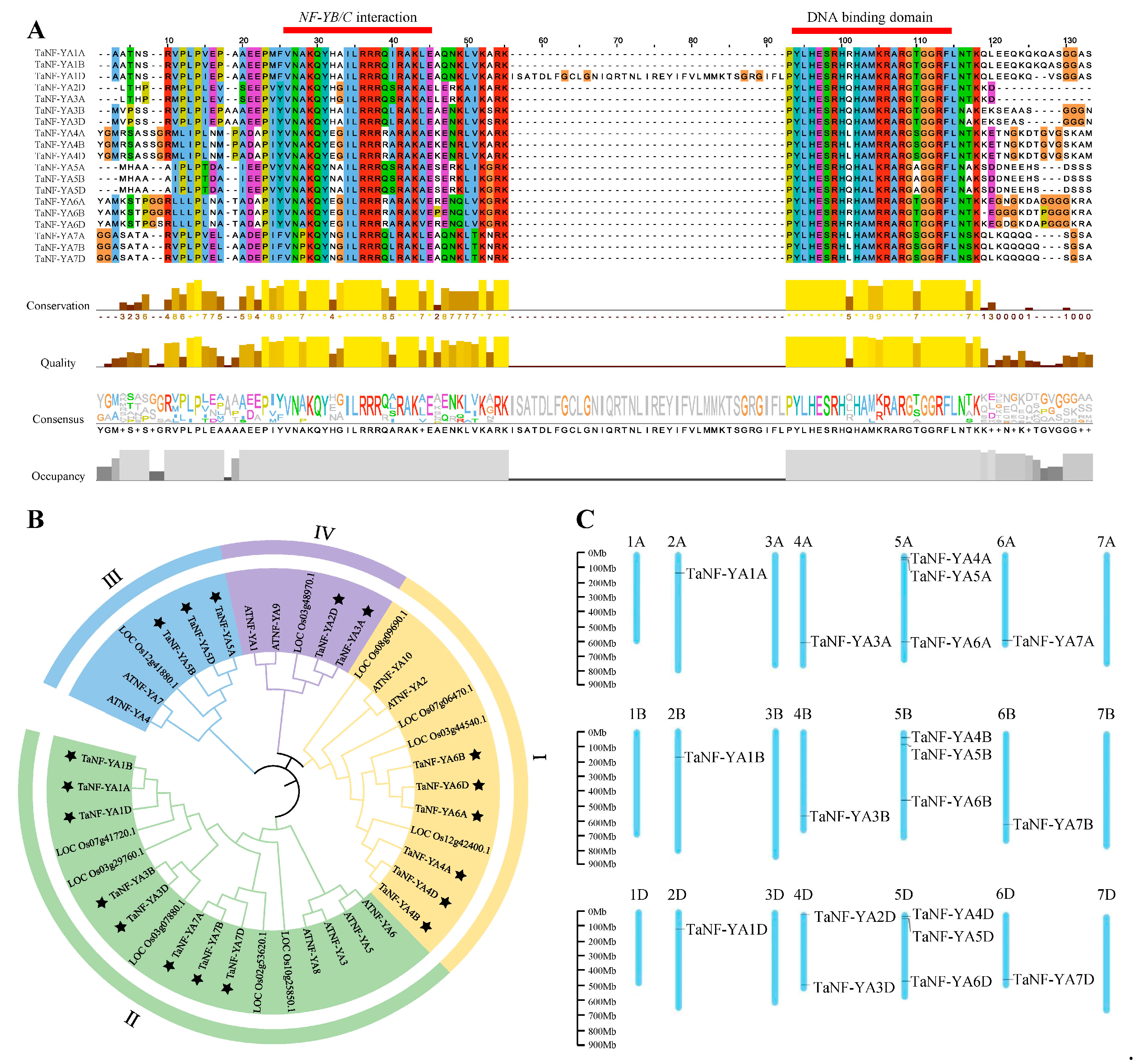
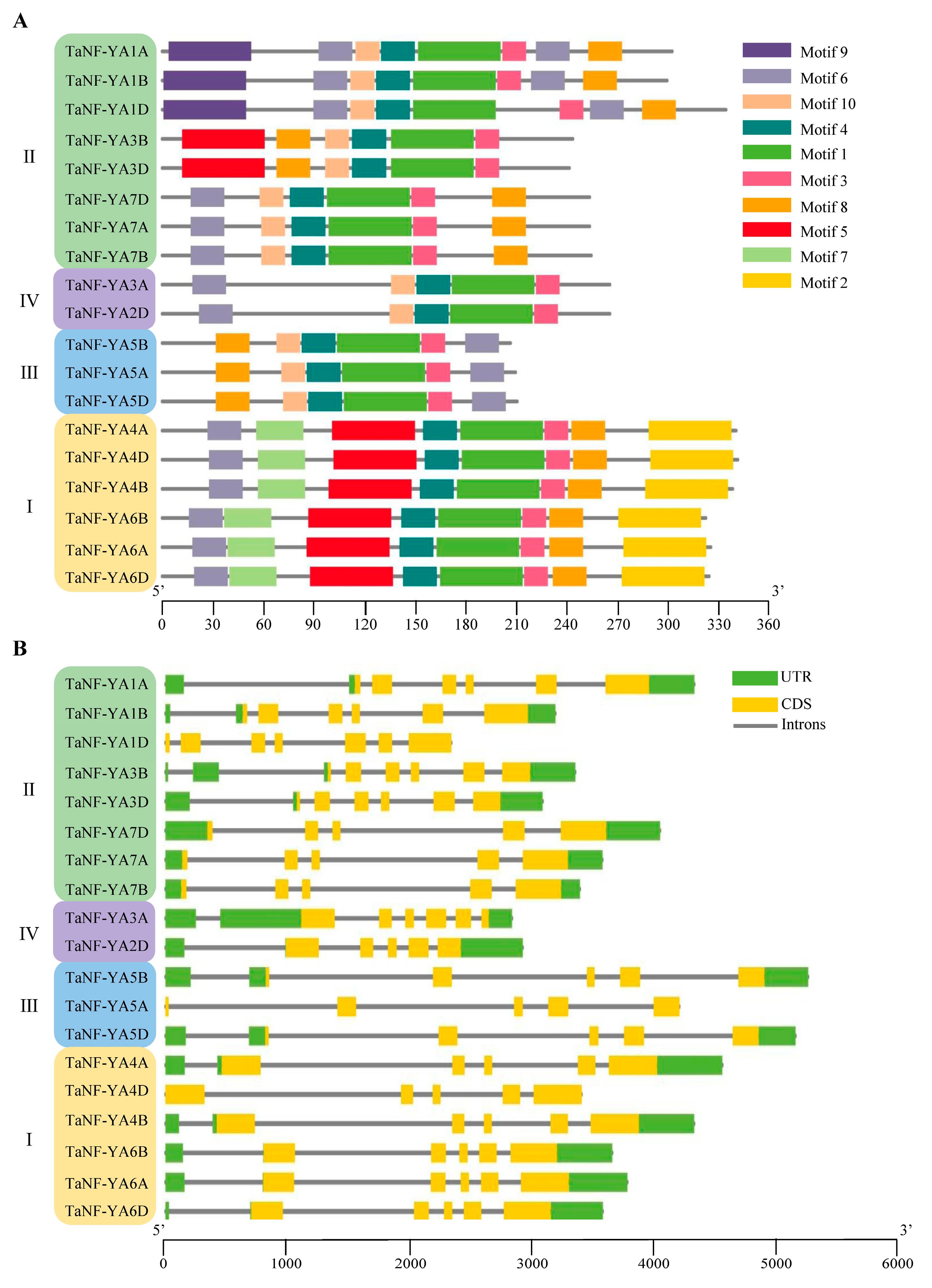
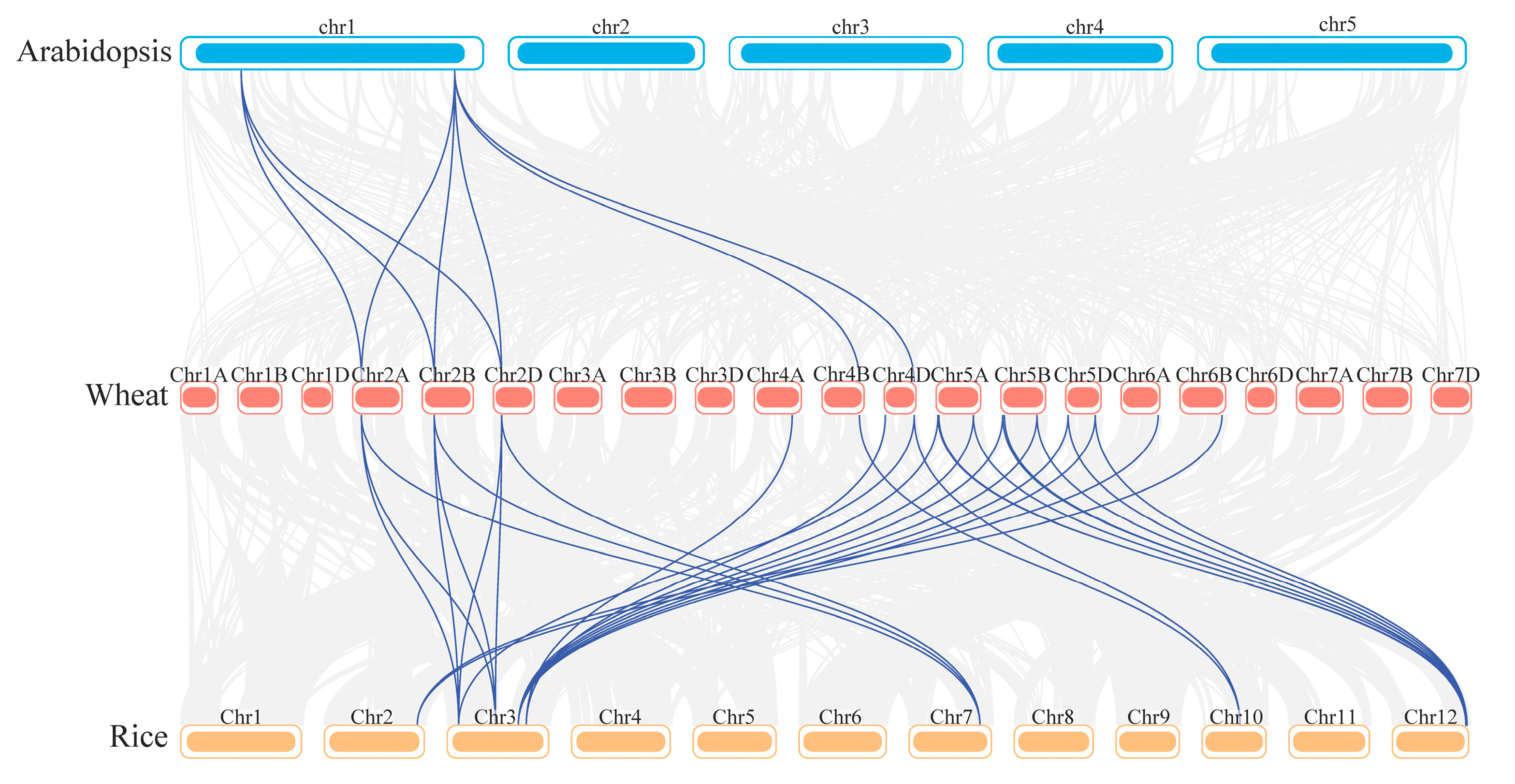
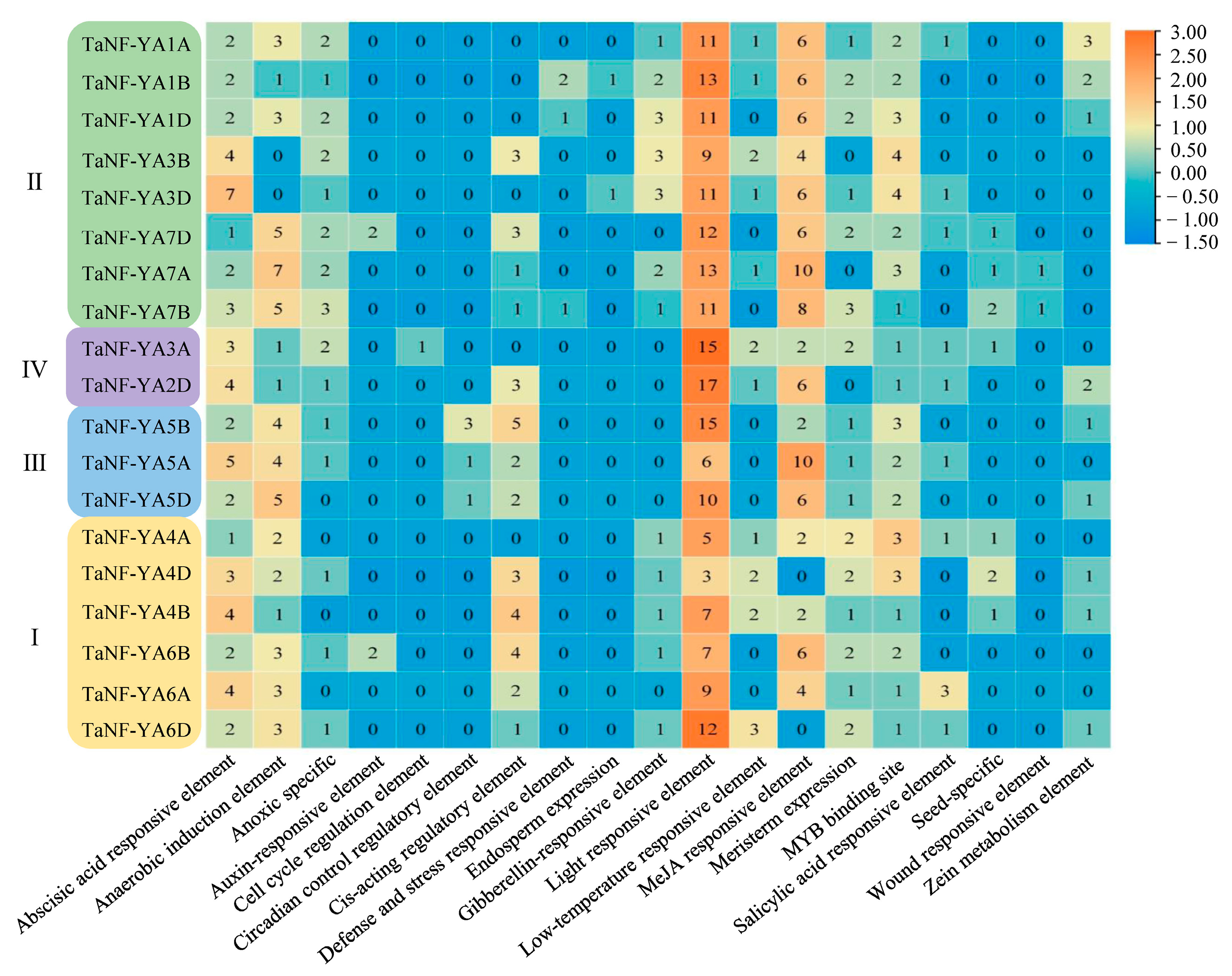
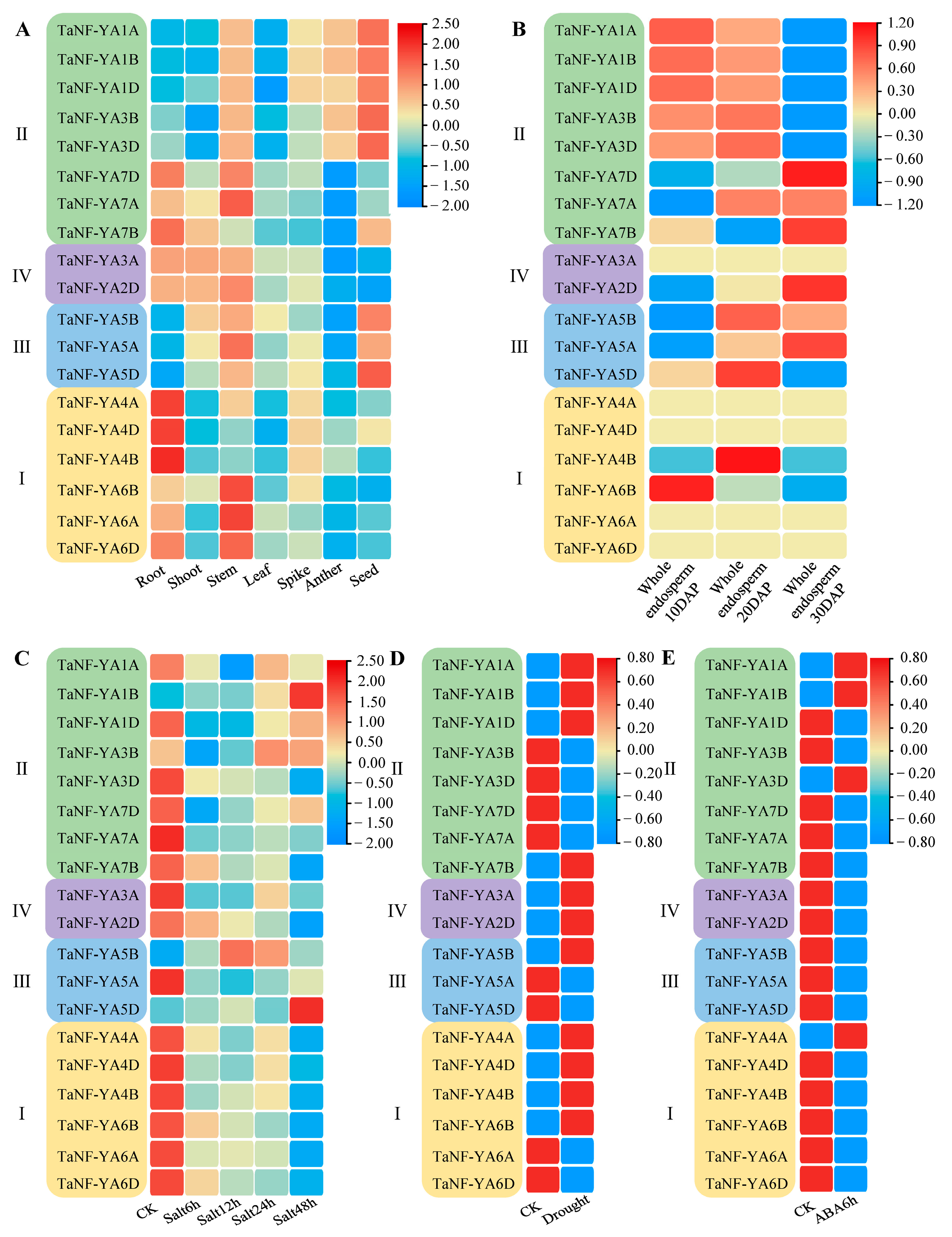
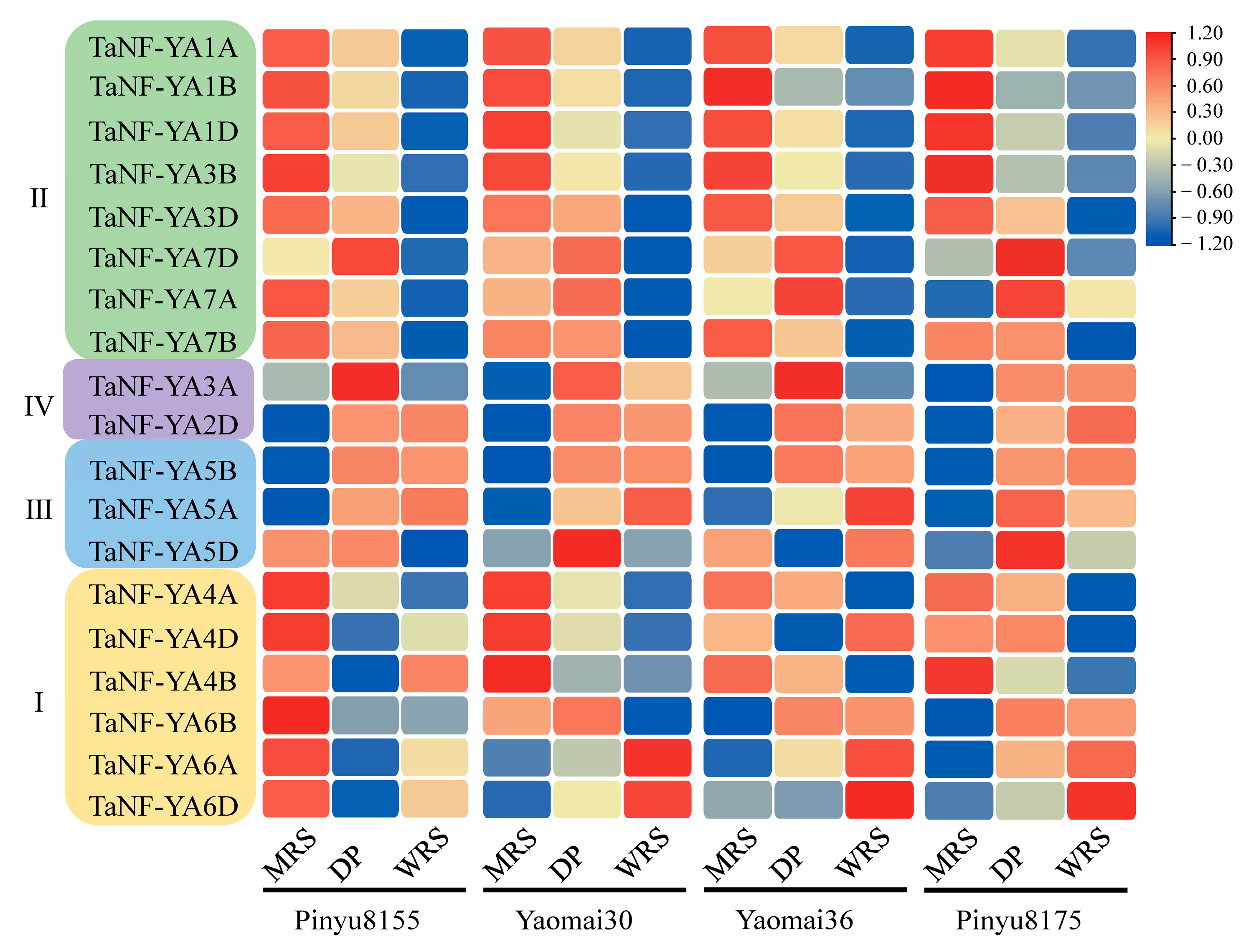
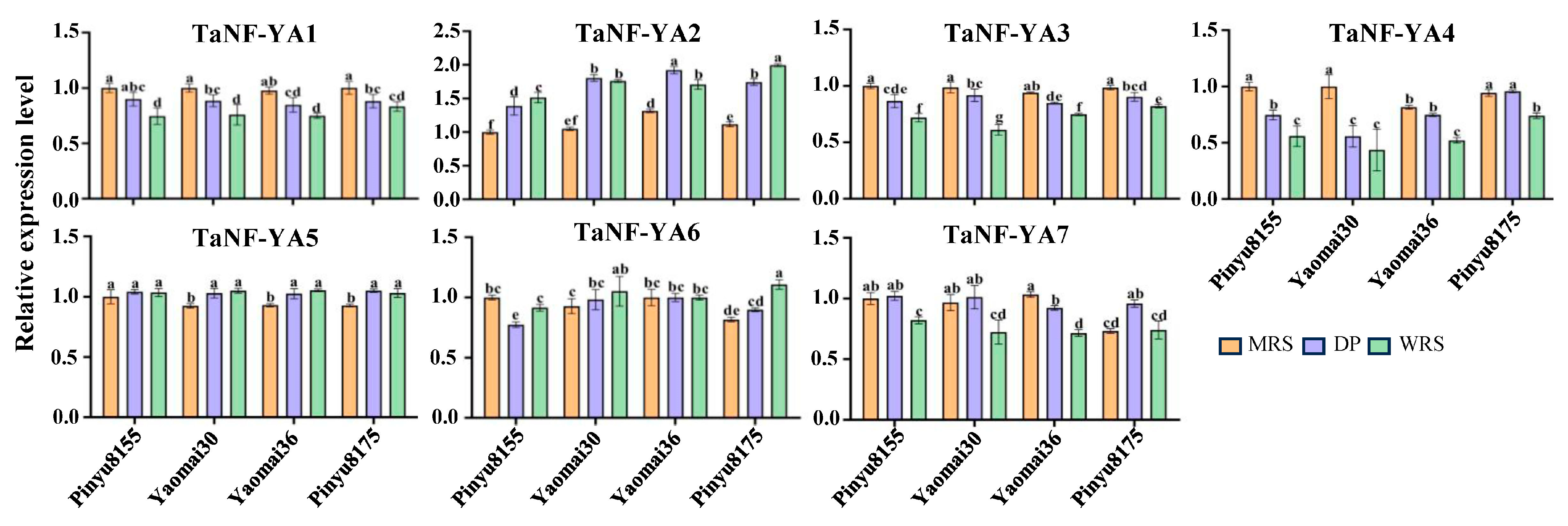

| Gene Name | Gene ID | Chr | Start | End | CDS Length (bp) | Amino Acid Length (aa) | MW (KDa) | pI | Subcellular Location |
|---|---|---|---|---|---|---|---|---|---|
| TaNF-YA1A | TraesCS2A03G0358600 | 2A | 133,675,481 | 133,679,820 | 912 | 303 | 33.08 | 9.62 | Nucleus |
| TaNF-YA1B | TraesCS2B03G0478600 | 2B | 184,491,589 | 184,494,788 | 903 | 300 | 32.80 | 9.70 | Nucleus |
| TaNF-YA1D | TraesCS2D03G0374600 | 2D | 126,142,858 | 126,145,203 | 1008 | 335 | 36.70 | 9.62 | Nucleus |
| TaNF-YA2D | TraesCS4D03G0056200 | 4D | 15,856,361 | 15,859,292 | 801 | 266 | 28.70 | 9.15 | Nucleus |
| TaNF-YA3A | TraesCS4A03G0713900 | 4A | 584,263,143 | 584,265,986 | 801 | 266 | 28.72 | 9.41 | Nucleus |
| TaNF-YA3B | TraesCS4B03G0764200 | 4B | 574,599,438 | 574,602,800 | 735 | 244 | 26.56 | 9.34 | Nucleus |
| TaNF-YA3D | TraesCS4D03G0686200 | 4D | 460,899,556 | 460,902,650 | 729 | 242 | 26.41 | 9.32 | Nucleus |
| TaNF-YA4A | TraesCS5A03G0073100 | 5A | 27,789,570 | 27,794,138 | 1026 | 341 | 37.01 | 8.86 | Nucleus |
| TaNF-YA4B | TraesCS5B03G0067200 | 5B | 27,706,506 | 27,710,843 | 1020 | 339 | 36.77 | 8.86 | Nucleus |
| TaNF-YA4D | TraesCS5D03G0096600 | 5D | 37,108,522 | 37,111,936 | 1029 | 342 | 37.02 | 8.65 | Nucleus |
| TaNF-YA5A | TraesCS5A03G0110100 | 5A | 41,592,229 | 41,596,445 | 633 | 210 | 22.58 | 7.90 | Nucleus |
| TaNF-YA5B | TraesCS5B03G0121600 | 5B | 54,106,639 | 54,111,911 | 624 | 207 | 22.28 | 7.90 | Nucleus |
| TaNF-YA5D | TraesCS5D03G0131000 | 5D | 50,555,036 | 50,560,204 | 636 | 211 | 22.74 | 7.90 | Nucleus |
| TaNF-YA6A | TraesCS5A03G0896800 | 5A | 573,400,560 | 573,404,349 | 981 | 326 | 35.06 | 9.20 | Nucleus |
| TaNF-YA6B | TraesCS5B03G0942800 | 5B | 556,202,392 | 556,206,057 | 972 | 323 | 34.61 | 8.81 | Nucleus |
| TaNF-YA6D | TraesCS5D03G0858600 | 5D | 455,426,682 | 455,430,270 | 978 | 325 | 34.84 | 9.20 | Nucleus |
| TaNF-YA7A | TraesCS6A03G0864300 | 6A | 570,722,413 | 570,725,998 | 765 | 254 | 24.53 | 9.89 | Nucleus |
| TaNF-YA7B | TraesCS6B03G1035100 | 6B | 647,043,462 | 647,046,862 | 768 | 255 | 27.70 | 9.89 | Nucleus |
| TaNF-YA7D | TraesCS6D03G0733500 | 6D | 445,208,290 | 445,212,347 | 765 | 254 | 27.70 | 9.77 | Nucleus |
| Homologous Genes | Ka | Ks | Ka/Ks | Homologous Fragment Length | Identities (%) | |
|---|---|---|---|---|---|---|
| Gene 1 | Gene 2 | |||||
| TaNF-YA1A | TaNF-YA1B | 0.02368 | 0.06350 | 0.37283 | 900 | 95.51 |
| TaNF-YA1A | TaNF-YA1D | 0.03145 | 0.06904 | 0.45557 | 894 | 96.52 |
| TaNF-YA1B | TaNF-YA1D | 0.02228 | 0.04906 | 0.45409 | 894 | 97.25 |
| TaNF-YA2D | TaNF-YA3A | 0.02788 | 0.20110 | 0.13865 | 783 | 90.88 |
| TaNF-YA3B | TaNF-YA3D | 0.00730 | 0.13063 | 0.05586 | 726 | 94.70 |
| TaNF-YA4A | TaNF-YA4B | 0.00916 | 0.09089 | 0.10081 | 1014 | 94.51 |
| TaNF-YA4A | TaNF-YA4D | 0.00647 | 0.09925 | 0.06524 | 1023 | 97.08 |
| TaNF-YA4A | TaNF-YA6D | 0.21782 | 1.01595 | 0.21440 | 951 | 84.38 |
| TaNF-YA4B | TaNF-YA4D | 0.00521 | 0.06768 | 0.07705 | 1017 | 97.28 |
| TaNF-YA4B | TaNF-YA6D | 0.21387 | 1.00565 | 0.21267 | 948 | 84.38 |
| TaNF-YA4D | TaNF-YA6D | 0.22150 | 0.99874 | 0.22178 | 951 | 84.38 |
| TaNF-YA5A | TaNF-YA5B | 0.01386 | 0.11561 | 0.11988 | 618 | 94.79 |
| TaNF-YA5A | TaNF-YA5D | 0.00417 | 0.10015 | 0.04166 | 630 | 97.01 |
| TaNF-YA5B | TaNF-YA5D | 0.01807 | 0.08383 | 0.21561 | 621 | 92.92 |
| TaNF-YA6A | TaNF-YA6B | 0.02831 | 0.09301 | 0.30438 | 960 | 92.15 |
| TaNF-YA6A | TaNF-YA6D | 0.02667 | 0.12945 | 0.20605 | 969 | 93.27 |
| TaNF-YA6B | TaNF-YA6D | 0.02111 | 0.13037 | 0.16191 | 963 | 93.42 |
| TaNF-YA7A | TaNF-YA7B | 0.00698 | 0.09714 | 0.07190 | 762 | 94.89 |
| Gene ID | Variety | Geographical Location Distribution | Variety Type | ||||||||
|---|---|---|---|---|---|---|---|---|---|---|---|
| Spelt | Cultivate | Landrace | Asia | Africa | Europe | N_ America | S_ America | Facultative | Spring | Winter | |
| TaNF-YA1A | 13 | 6 | 13 | 27 | 5 | 17 | 5 | 2 | 3 | 21 | 20 |
| TaNF-YA1B | 13 | 9 | 21 | 33 | 3 | 21 | 3 | 3 | 8 | 19 | 27 |
| TaNF-YA1D | 4 | 1 | 9 | 11 | 2 | 5 | 1 | 2 | 3 | 8 | 6 |
| TaNF-YA2D | 6 | 2 | 5 | 10 | 4 | 7 | 2 | 1 | 1 | 9 | 7 |
| TaNF-YA3A | 12 | 2 | 9 | 22 | 4 | 12 | 1 | 1 | 4 | 13 | 15 |
| TaNF-YA3B | 14 | 6 | 11 | 17 | 3 | 20 | 1 | 2 | 2 | 15 | 21 |
| TaNF-YA3D | 0 | 0 | 0 | 0 | 0 | 0 | 0 | 0 | 0 | 0 | 0 |
| TaNF-YA4A | 3 | 2 | 4 | 4 | 1 | 4 | 1 | 2 | 3 | 2 | 4 |
| TaNF-YA4B | 0 | 0 | 0 | 0 | 0 | 0 | 0 | 0 | 0 | 0 | 0 |
| TaNF-YA4D | 7 | 3 | 6 | 15 | 4 | 8 | 1 | 3 | 3 | 11 | 10 |
| TaNF-YA5A | 14 | 8 | 25 | 41 | 5 | 22 | 2 | 2 | 6 | 25 | 29 |
| TaNF-YA5B | 14 | 8 | 34 | 46 | 6 | 21 | 2 | 2 | 7 | 36 | 28 |
| TaNF-YA5D | 4 | 1 | 2 | 2 | 1 | 4 | 2 | 1 | 1 | 3 | 3 |
| TaNF-YA6A | 7 | 6 | 9 | 12 | 4 | 9 | 2 | 2 | 3 | 9 | 11 |
| TaNF-YA6B | 14 | 8 | 20 | 37 | 5 | 18 | 4 | 2 | 4 | 28 | 22 |
| TaNF-YA6D | 8 | 1 | 3 | 14 | 5 | 8 | 1 | 1 | 3 | 9 | 7 |
| TaNF-YA7A | 14 | 7 | 30 | 44 | 6 | 24 | 3 | 2 | 5 | 30 | 34 |
| TaNF-YA7B | 14 | 7 | 18 | 30 | 5 | 22 | 4 | 2 | 6 | 21 | 23 |
| TaNF-YA7D | 0 | 0 | 0 | 0 | 0 | 0 | 0 | 0 | 0 | 0 | 0 |
| Variety | Gene Name | FPKM Mean | p-Value | Level | ||
|---|---|---|---|---|---|---|
| MRS | DP | WRS | ||||
| Pinyu8155 | TaNF-YA1A | 9.2427 | 8.2509 | 6.6084 | 1.42397 × 10−54 | significant |
| TaNF-YA1B | 8.6953 | 7.6101 | 6.2446 | 8.06098 × 10−57 | significant | |
| TaNF-YA1D | 9.4130 | 8.7314 | 7.5454 | 1.23465 × 10−18 | significant | |
| TaNF-YA2D | 3.2953 | 4.5944 | 4.6723 | 0.019459322 | significant | |
| TaNF-YA3B | 8.6177 | 7.5035 | 6.6598 | 2.68707 × 10−17 | significant | |
| TaNF-YA3D | 9.0269 | 8.2087 | 6.0066 | 4.35495 × 10−34 | significant | |
| TaNF-YA4A | 4.2471 | 2.8896 | 2.1787 | 4.23058 × 10−8 | significant | |
| TaNF-YA4D | 4.5815 | 3.5064 | 3.9296 | 0.000959117 | significant | |
| TaNF-YA5A | 6.8201 | 7.5547 | 7.6498 | 2.63508 × 10−6 | significant | |
| TaNF-YA5D | 7.6664 | 7.6808 | 7.2214 | 0.006655729 | significant | |
| TaNF-Y6D | 4.9625 | 3.8850 | 4.5690 | 0.003850238 | significant | |
| TaNF-YA7B | 4.9012 | 4.6018 | 3.8650 | 0.002255128 | significant | |
| TaNF-YA7D | 4.4480 | 4.9347 | 3.9810 | 0.002752711 | significant | |
| Yaomai30 | TaNF-YA1A | 9.2266 | 8.0759 | 6.5569 | 3.4975 × 10−68 | significant |
| TaNF-YA1B | 8.6308 | 7.4663 | 6.2025 | 1.64548 × 10−50 | significant | |
| TaNF-YA1D | 9.2164 | 8.4105 | 7.7947 | 5.4985 × 10−16 | significant | |
| TaNF-YA2D | 3.5246 | 5.9733 | 5.7686 | 2.31801 × 10−15 | significant | |
| TaNF-YA3A | 4.3450 | 5.2354 | 4.9273 | 0.018687011 | significant | |
| TaNF-YA3B | 8.5723 | 7.5461 | 6.5612 | 2.79623 × 10−16 | significant | |
| TaNF-YA3D | 9.1852 | 8.4993 | 5.6980 | 2.01475 × 10−40 | significant | |
| TaNF-YA4A | 4.0146 | 2.1491 | 1.1342 | 1.46941 × 10−11 | significant | |
| TaNF-YA4B | 4.3123 | 2.9474 | 2.7664 | 0.000618621 | significant | |
| TaNF-YA4D | 4.9266 | 4.3011 | 3.8881 | 0.006868434 | significant | |
| TaNF-YA5A | 6.6612 | 7.1964 | 7.4600 | 0.000297905 | significant | |
| TaNF-YA5B | 6.8550 | 7.7639 | 7.7562 | 3.74578 × 10−9 | significant | |
| TaNF-YA6A | 4.4237 | 4.6709 | 5.3353 | 0.002324020 | significant | |
| TaNF-YA6B | 4.3938 | 4.5630 | 3.5285 | 0.009245228 | significant | |
| TaNF-YA6D | 4.9368 | 5.3232 | 5.7216 | 0.004492247 | significant | |
| TaNF-YA7A | 4.8932 | 5.2123 | 3.9293 | 0.000295765 | significant | |
| TaNF-YA7B | 4.3957 | 4.3197 | 3.0679 | 0.003992178 | significant | |
| TaNF-YA7D | 4.3183 | 4.7026 | 3.1900 | 0.000811669 | significant | |
| Yaomai36 | TaNF-YA1A | 9.0306 | 7.9856 | 6.7145 | 0.000365685 | significant |
| TaNF-YA1B | 8.5750 | 7.0378 | 6.7101 | 2.82713 × 10−10 | significant | |
| TaNF-YA1D | 9.1267 | 8.1578 | 7.0790 | 2.44115 × 10−5 | significant | |
| TaNF-YA2D | 4.2185 | 6.1064 | 5.7250 | 5.07876 × 10−5 | significant | |
| TaNF-YA3B | 8.2840 | 7.4122 | 6.6357 | 0.000300512 | significant | |
| TaNF-YA4B | 3.6900 | 3.3183 | 2.2875 | 0.002718470 | significant | |
| TaNF-YA5A | 6.7630 | 7.1355 | 7.5710 | 0.013510010 | significant | |
| TaNF-YA5B | 6.8289 | 7.7378 | 7.6101 | 0.003405333 | significant | |
| TaNF-YA7B | 4.9223 | 4.3562 | 3.3867 | 0.000261033 | significant | |
| Pinyu8175 | TaNF-YA1A | 9.1541 | 8.1787 | 7.4869 | 3.00122 × 10−17 | significant |
| TaNF-YA1B | 8.5854 | 7.4209 | 7.2649 | 1.74623 × 10−24 | significant | |
| TaNF-YA1D | 9.6246 | 8.5066 | 8.0277 | 1.28126 × 10−15 | significant | |
| TaNF-YA2D | 3.6950 | 5.7659 | 6.5086 | 2.54353 × 10−14 | significant | |
| TaNF-YA3B | 8.5155 | 7.6455 | 7.3909 | 1.86229 × 10−6 | significant | |
| TaNF-YA3D | 8.8771 | 8.3205 | 7.2108 | 6.22932 × 10−10 | significant | |
| TaNF-YA4D | 4.1775 | 4.2057 | 3.2935 | 0.016155841 | significant | |
| TaNF-YA5A | 6.7540 | 7.5032 | 7.2890 | 0.000185483 | significant | |
| TaNF-YA5B | 6.7807 | 7.7076 | 7.7768 | 9.91354 × 10−11 | significant | |
| TaNF-YA6D | 4.0213 | 4.4202 | 5.4000 | 0.000200123 | significant | |
| TaNF-YA7A | 3.3347 | 4.3805 | 3.8482 | 0.016966263 | significant | |
| TaNF-YA7D | 3.4529 | 4.6553 | 3.1579 | 0.000111526 | significant | |
Disclaimer/Publisher’s Note: The statements, opinions and data contained in all publications are solely those of the individual author(s) and contributor(s) and not of MDPI and/or the editor(s). MDPI and/or the editor(s) disclaim responsibility for any injury to people or property resulting from any ideas, methods, instructions or products referred to in the content. |
© 2024 by the authors. Licensee MDPI, Basel, Switzerland. This article is an open access article distributed under the terms and conditions of the Creative Commons Attribution (CC BY) license (https://creativecommons.org/licenses/by/4.0/).
Share and Cite
Zhang, Y.; Xu, Y.; Mao, Y.; Tan, X.; Tian, Y.; Ma, X.; Ji, H.; Zhang, D. Genome-Wide Identification and Expression Analysis of NF-YA Gene Family in the Filling Stage of Wheat (Triticum aestivum L.). Int. J. Mol. Sci. 2025, 26, 133. https://doi.org/10.3390/ijms26010133
Zhang Y, Xu Y, Mao Y, Tan X, Tian Y, Ma X, Ji H, Zhang D. Genome-Wide Identification and Expression Analysis of NF-YA Gene Family in the Filling Stage of Wheat (Triticum aestivum L.). International Journal of Molecular Sciences. 2025; 26(1):133. https://doi.org/10.3390/ijms26010133
Chicago/Turabian StyleZhang, Yang, Yanmin Xu, Yulu Mao, Xiaodi Tan, Yuan Tian, Xiaofei Ma, Hutai Ji, and Dingyi Zhang. 2025. "Genome-Wide Identification and Expression Analysis of NF-YA Gene Family in the Filling Stage of Wheat (Triticum aestivum L.)" International Journal of Molecular Sciences 26, no. 1: 133. https://doi.org/10.3390/ijms26010133
APA StyleZhang, Y., Xu, Y., Mao, Y., Tan, X., Tian, Y., Ma, X., Ji, H., & Zhang, D. (2025). Genome-Wide Identification and Expression Analysis of NF-YA Gene Family in the Filling Stage of Wheat (Triticum aestivum L.). International Journal of Molecular Sciences, 26(1), 133. https://doi.org/10.3390/ijms26010133







